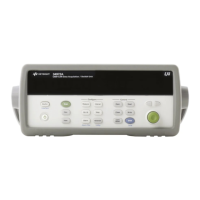7Tutorial
306 Keysight 34970A/34972A User’s Guide
Offset Compensation
Most connections in a system use materials that produce small DC voltages due
to dissimilar metal-to-metal contact (thermocouple effect) or electrochemical
batteries (for a description of the thermocouple effect, see page 272). These DC
voltages also add errors to resistance measurements. The offset-compensated
measurement is designed to allow resistance measurements in the presence of
small DC voltages.
Offset compensation makes two measurements on the circuit connected to the
input channel. The first measurement is a conventional resistance measurement.
The second is the same except the internal DMM’s test current source is turned off
(essentially a normal DC voltage measurement). The second measurement is
subtracted from the first prior to scaling the result, thus giving a more accurate
resistance measurement. Refer to “Offset Compensation” on page 144 for more
information.
Offset compensation can be used for 2-wire or 4-wire ohms measurements (but
not for RTD or thermistor measurements). The 34970A/34972A disables offset
compensation when the measurement function is changed or after a Factory
Reset (*RST command). An Instrument Preset (SYSTem:PRESet command) or
Card Reset (SYSTem:CPON command) does not change the setting.
If the resistor being measured does not respond quickly to changes in current,
offset compensation will not produce an accurate measurement. Resistors with
very large inductances or resistors with large parallel capacitance would fall into
this category. In these cases, the channel delay parameter can be increased to
allow more settling time after the current source is switched on or off, or offset
compensation can be turned off. For more information on channel delay, see page
119.

